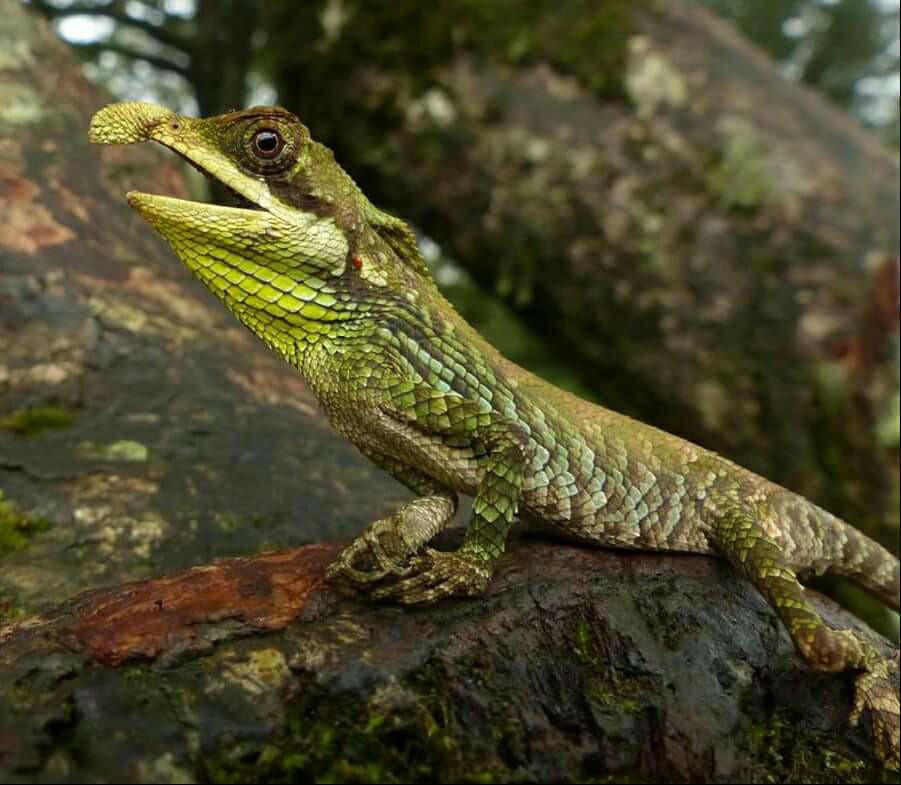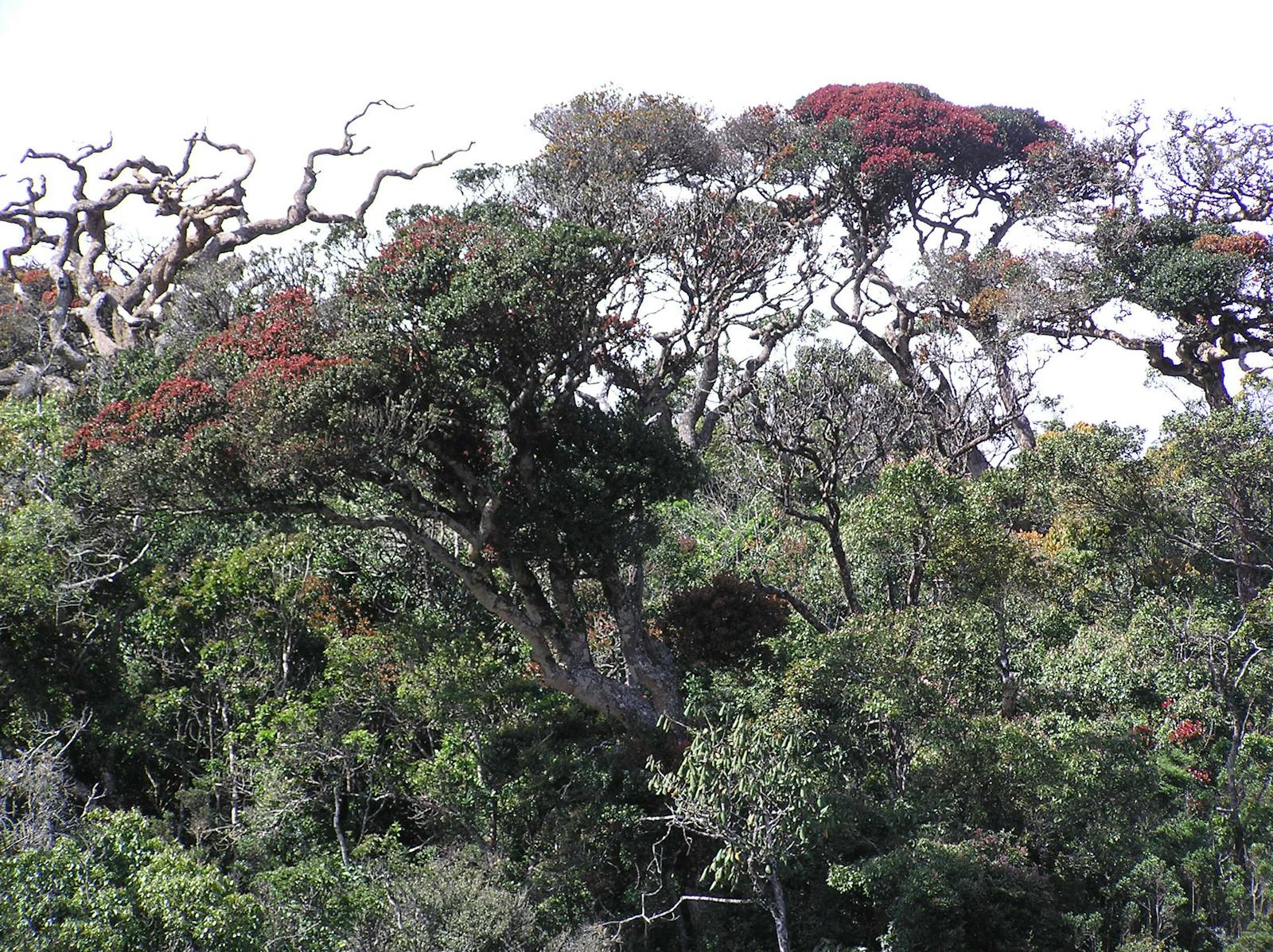Sri Lanka Montane Rainforests
The ecoregion’s land area is provided in units of 1,000 hectares. The protection goal is the Global Safety Net (GSN1) area for the given ecoregion. The protection level indicates the percentage of the GSN goal that is currently protected on a scale of 0-10.
Bioregion: Northern Deccan & Odisha Tropical Forests (IM7)
Realm: Indomalaya
Subrealm: Indian Subcontinent
Ecoregion Size (1000 ha):
309
Ecoregion ID:
275
Conservation Target:
95%
Protection Level:
2
States: Sri Lanka
The Sri Lanka Montane Rain Forests ecoregion represents the island’s montane and sub-montane wet forests above 1,000 m. After the Miocene-era geologic upheaval over 7 million years ago that created these mountains, the forests and the species in them have been isolated from the rainforests in the Indian subcontinent. Over time, the flora and fauna evolved into new species that are now endemic to the rainforests of Sri Lanka, including to the montane rainforests.

The leaf-nosed lizard (Ceratophora tennentii) is the flagship species of the Sri Lanka Montane Rainforests ecoregion. Image credit: Moni Ostermaier, CC BY-SA-4.0
The forest vegetation ranges from the tall sub-montane forests to cloud forests with stunted, twisted trees on wind-swept slopes in the upper mountains rising to over 2,500 m. The sub-montane forests are dominated by tall tree species of Shorea, Calophyllum and Syzygium.
In the higher elevations, the cloud forests are characterized by moss-draped, endemic Rhododendron species, giant tree ferns of Cyathea species, and an understory with endemic Strobilanthes species that bloom every twelve years, creating a tapestry of purple, yellow and orange. The cloud forests are interspersed with montane grasslands, locally known as pathanas.
Asian elephants used to roam these grasslands, but have now been extirpated. However, the Sri Lankan leopard and their principal prey, sambar deer are still abundant here.
The monsoon wind and rain, along with morning fog and mist, play a large part in shaping the forest communities and their structure. The ecoregion receives 2,500 to 5,000 mm of rainfall annually, mostly from May to September. The strong winds restrict the trees from growing tall on the higher slopes with shallow soils. Despite the tropical location, ground frost is not uncommon in the higher elevations during the nights from December to February.
Over half of Sri Lanka’s endemic flowering plants and endemic vertebrates are limited to this ecoregion, and new species are still being discovered and described, especially among the smaller, cryptic fauna, such as frogs, lizards, fishes, and brightly colored freshwater crabs. The smaller, isolated Knuckles mountain range to the north of the central mountains harbors many species of endemic flora and fauna, including the leaf-nosed lizards in the genus Ceratophora, which have a distinct ‘horn’ at the tip of the snout with a shape unique to each species. The genus itself is a taxonomic relict, a once widespread group that is now confined to Sri Lanka’s rainforests.

Sri Lankan leopard. Image credit: Gerard Mendis, Creative Commons
Over the past two centuries, most of the montane rainforests have been cleared for large tea plantations. Although this made ‘Ceylon Tea’ a famous brand worldwide, it took a heavy toll on the island’s biodiversity; we will never know the full extent of the endemic biodiversity that has been lost forever. But the highly localized distribution patterns of species provide some indication of how severe the losses had been. Forest loss still continues, although at smaller scales.
Because many of the endemic species are habitat specialists and have limited distributions, even small habitat fragments can provide refuge for many of the irreplaceable species with small range distributions. The ecoregion has five protected areas, with the major ones being Horton Plains National Park and Knuckles Conservation Area. None have good protection measures or conservation plans in place.
Priority conservation action should be to:
- Connect the forest patches to create larger contiguous landscapes, including through strategic restoration, to extend connectivity along the elevational gradient to also link with the Sri Lanka Lowland Rain Forests ecoregion.
- Create a Green Fund to purchase strategic lands for conservation set-asides and establish Public-Private Partnerships to manage Forest Reserves.
- Protect and restore all forests above ~1,515 m elevation as per the law.
-
-
1. National Biodiversity Strategic Action Plan 2016-2022, Sri Lanka. Biodiversity Secretariat, Ministry of Mahaweli Development and Environment. May 2016.
2. Wikramanayake, E, E. Dinerstein, et al. 2002. Terrestrial Ecoregions of the Indo-Pacific: A Conservation Assessment. Island Press.
3. Integrated Spatial Planning and Analysis to Prioritize Biodiversity Conservation in Sri Lanka. Environmental Foundation, Ltd and National Biodiversity Secretariat, Sri Lanka. 2017 -
Cite this page: Sri Lanka Montane Rainforests. Ecoregion Snapshots: Descriptive Abstracts of the Terrestrial Ecoregions of the World, 2021. Developed by One Earth and RESOLVE. https://www.oneearth.org/ecoregions/sri-lanka-montane-rainforests/
-




